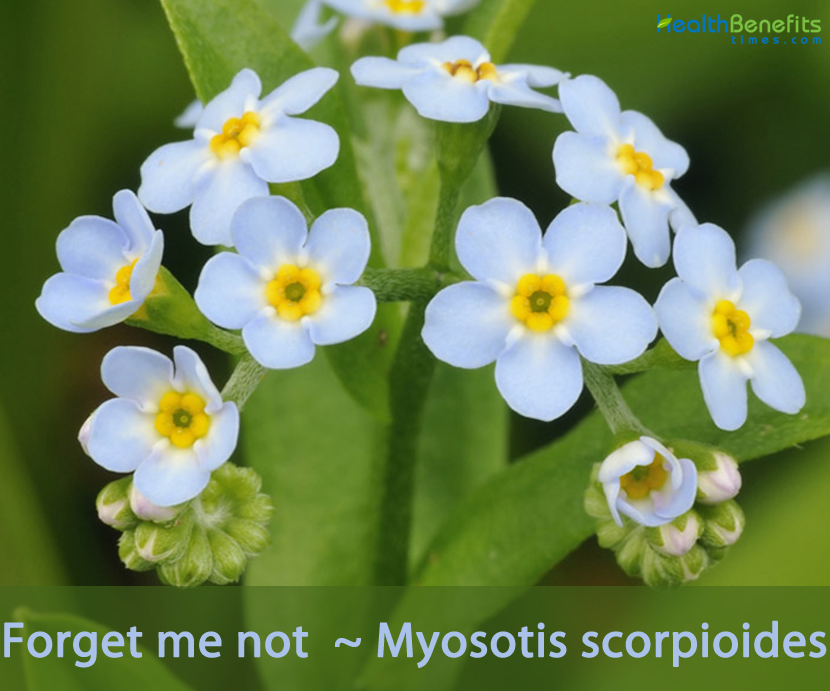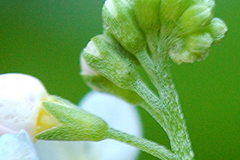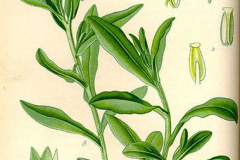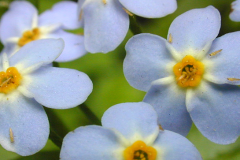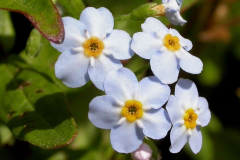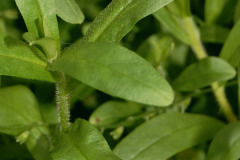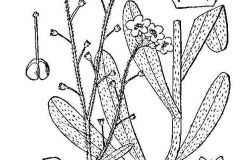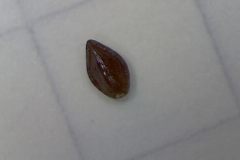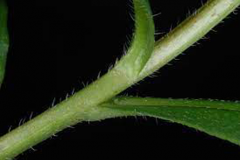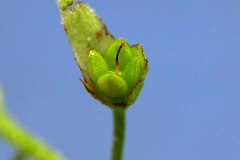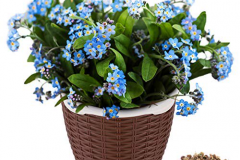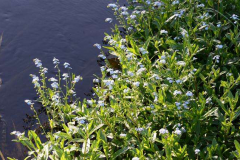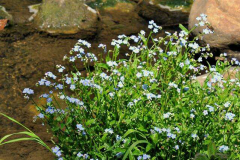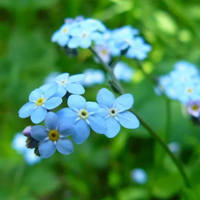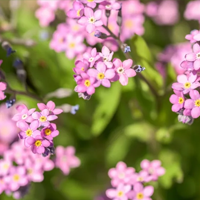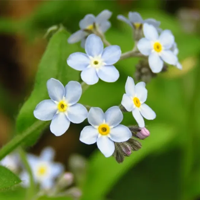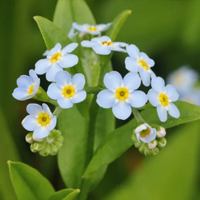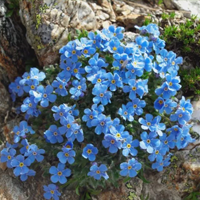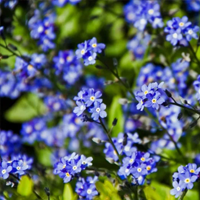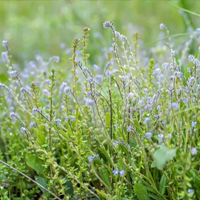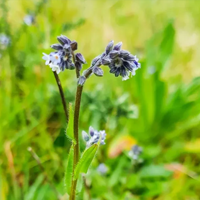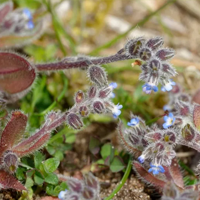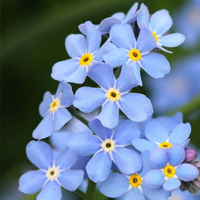| Water Forget me not Quick Facts | |
|---|---|
| Name: | Water Forget me not |
| Scientific Name: | Myosotis scorpioides |
| Origin | Europe and Asia, but is widely distributed elsewhere, including much of North America |
| Shapes | Dark, shiny, egg shaped nutlets (mericarps) 2 to 2.5 mm long and smooth |
| Taste | Sweet and grassy taste |
| Health benefits | Support whooping cough, bronchitis, nose bleed, asthma, allergy, lung diseases, fights premature aging, blemishes, wrinkles and reduces dark spots |
| Name | Water forget me not |
|---|---|
| Scientific Name | Myosotis scorpioides |
| Native | Europe and Asia, but is widely distributed elsewhere, including much of North America, as an introduced species and sometimes a noxious weed. The plant is common and widespread in Britain, however is very rare in Jersey |
| Common Names | Yellow eye forget-me-not, Forget-me-not, large-seed forget-me-not, true forget-me-not, water Forget-me-not, Scorpion Weed, Love-me, Marsh Scorpion Grass, Mouse-Ear Scorpion Grass, Snake Grass, Water Scorpion-Grass, Common Water Forget-Me-Not, European Forget-Me-Not, Large Forget-Me-Not, Water Scorpion grass, Marsh forget-me-not |
| Name in Other Languages | Albanian: Lulemiza e moçaleve, lulemizë Arabic: Anaghlis (أناغلس) Basque: Oroilore urtar Belarusian: Niezabudka balotnaja (Незабудка балотная) Bulgarian: Blatna nezabravka (блатна незабравка) Catalan: Miosotis palustre Chinese: Zhǎozé wùwàngcǎo (沼泽勿忘草) Cornish: Skorpyonles Croatian: Močvarna potočnica Czech: Pomněnka bahenní Danish: Eng-forglemmigej, Lyng-Snerre, Rundbladet Snerre, Sump-Snerre, Uægte Burre-Snerre Dutch: Moerasvergeet-mij-niet, moerasvergeet-mij-nietje, Moeras- en Weidevergeet-mij-nietje, Moerasvergeet-me-nietje, English: Water forget-me-not, true forget-me-not, Forget-Me-Not, Water Scorpion-Grass, Yelloweye Forget-Me-Not, Common Water Forget-Me-Not, European Forget-Me-Not, Large Forget-Me-Not, Mouse-Ear Scorpiongrass, Water Scorpiongrass, Marsh forget-me-not Estonian: Soo-lõosilm Faroese: Mýrihoylús Finnish: Meriluhtalemmikki, Nummimatara, Peltomatara, Luhtalemmikki, French: Aimez-moi, herbe grasse, myosotis des marais, myosotis faux scorpion, myosotis faux-scorpion, myosotis scorpioïde, ne-m’oubliez-pas, oreille de rat, oreille de souris, plus-je-te-vois-plus-je-t’aime, scorpione de marais, souvenez-vous-de-moi German: Sumpfvergißmeinnicht, Lockerblütiges Vergissmeinnicht, Myosotis palustris, Sumpf-Vergissmeinnicht, Sumpfvergissmeinnicht, Schlaffes Vergissmeinnicht, Hungarian: Mocsári nefelejcs Icelandic: Engjamunablóm Irish: Ceotharnach uisce Italian: Miosotide palustre, non-ti-scordar-di-me di palude, nontiscordardimé delle paludi, scorpiona di padule Japanese: Wasurenagusa (ワスレナグサ), Shinwasurenagusa (シンワスレナグサ) Kashubian: Błotnô niezabôtka Latvian: Purva neaizmirstule Lithuanian: Pelkinė neužmirštuolė Lower Sorbian: Bagnowe njezabyńki Northern Sami: Vajálgeahtesnásti Norwegian: Engforglemmegei, Kystmaure, Rundmaure, Småklengjemaure, Emalje-blomster, Forjæt mig ej, Jomfru-soløje, Solten Henric, Engminneblom Persian: فراموشم مکن آبزی, فراموشم مکن ابزی, گل فراموشم مکن آبزی Polish: Niezapominajka błotna, Russian: Nezabudka bolotnaya (незабудка болотная), nezabudka skorpionovidnaya (незабудка скорпионовидная), Nezabudka bolotnaya (Незабудка болотная) Serbian: Obychny spomenak (обични споменак), spomenak (споменак) Slovak: Nezábudka močiarna Slovene: Močvirska spominčica Spanish: Miosotis de agua, nomeolvides, nomeolvides de agua Swedish: Akta förgätmigej, Gles gulmåra, Gotlandsmåra, Småsnärjmåra, Stenmåra, Sumpmåra, Luhtalemmikki, Äkta förgätmigej, Blå ögontröst, Fansögon, Huggormsört, Jungfruöga, Skorpionört Turkish: Bataklık unutmabenisi Ukrainian: Nezabudka bolotna (незабудка болотна) Upper Sorbian: Bahnowa njezapomnička, Welsh: Ysgorpionllys y gors, Blodyn Glas, Glas y Ffrwd, Glas y Gors, Llys Cariad, Llys Coffa’r Gors, Llys y Gors, Na’d Fi’n Angof, Sgorpionllys y Gors, Siriol y Dwfr, Yscorpionllys, Ysgorpionllys y Gors, Ysgorpionlys y Gors |
| Plant Growth Habit | Evergreen, rhizomatous, herbaceous, creeping perennial, flowering plant |
| Growing Climates | Wet places by streams, pond margins, wet meadows, ditches, swamps, fen and rivers, marshes, riverine, wetland margins, along springs and slow-moving streams |
| Plant Size | Grows from 15 to 60 cm tall |
| Root | Roots are fibrous |
| Stem | Mostly unbranched, often angled, decumbent to erect, and inconspicuously hairy. |
| Leaf | Leaves are entire, alternate 2.5 to 8 cm long, and 7 to 20 mm wide with scattered, short, flat-lying hairs |
| Flowering season | May to September |
| Flower | Flowers are ¼ to 1/3 inch across, bright to pale blue, tubular with 5 spreading, round to egg shaped lobes |
| Fruit Shape & Size | Dark, shiny, egg shaped nutlets (mericarps) 2 to 2.5 mm long and smooth |
| Varieties |
|
| Taste | Sweet and grassy taste |
| Propagation | By seed or vegetatively by stolons |
| Season | July to September |
Plant Description
Water forget me not is an evergreen, rhizomatous, herbaceous, creeping perennial, flowering plant that normally grows from 15 to 60 cm tall. The plant is found growing in wet places by streams, pond margins, wet meadows, ditches, swamps, fen and rivers, marshes, riverine, wetland margins, along springs and slow-moving streams. Whilst it favors wet ground, it can survive submerged in water, and often can form floating rafts. Normally roots are fibrous. Stems are mostly unbranched, often angled, decumbent to erect, and inconspicuously hairy.
Stem
Stems are round in cross-section or angled, multiple from the base, creeping to erect, often rooting at the nodes and creating dense colonies from spreading runners (stolons). Stems become widely branched in the upper plant, variously covered in appressed hairs, sometimes spreading hairs. They can be up to 1 ½ foot tall (around half a meter) and are covered in white hair (around half a centimeter long).
Leaves
Leaves are entire, alternate 2.5 to 8 cm long, and 7 to 20 mm wide with scattered, short, flat-lying hairs. The lower leaves are mostly broadest above the middle, rounded at the tip, narrowed at the base to a short stalk, becoming smaller, stalk less or nearly so, and more lance-oblong as they ascend the stem. Surfaces are sparsely to moderately covered in short appressed hairs. Edges are toothless and may have a sparse fringe of hairs especially near the base. Upper leaves are oblong to elliptic and short petiolated or sessile.
Flower
Raceme of stalked flowers at the tips of branching stems, the cluster initially tightly curled at the tip with flowers opening in succession as the tip unfurls and elongates. Flowers are ¼ to 1/3 inch across, bright to pale blue, tubular with 5 spreading, round to egg shaped lobes. The base of the lobes has a scale-like swollen appendage that forms a bright to deep yellow collar around the throat. Flower stalks are about ¼ inch long, elongating in fruit.
The calyx surrounding the base of the flower is shorter than the stalk and has five triangular lobes that are shorter than the calyx tube. Floral tube is longer than the calyx, causing the flower to be flat or even convex across the top. The central stem, flower stalks and the calyx are sparsely to moderately covered in straight, appressed hairs. Flowering normally takes place in between May to September.
Fruit
Fertile flowers are followed by four parted, (a schizocarp) hidden inside the persistent calyx, splitting into four dark, shiny, egg shaped nutlets (mericarps) 2 to 2.5 mm long and smooth, the persistent style in the center is equal to or longer than the nutlets.
Legends regarding Water forget me not
There are many legends and folklores related with these perfectly pretty, delicate-looking yet sturdy flowers. Some of them are given below:
- When God was naming all the creatures and plants in the Garden of Eden, a tiny plant with blue flowers shouted from an obscure corner: “Forget me not, Lord!” And so, God named this tiny plant Forget me not.
- Another Greek legend goes: A man was roaming around with his lady love besides the river Danube when the lady saw a bush of bright little blooms across the river. The man swam across the river to fetch it for his lady but while returning, the strong tide swept him away. He, however, managed to throw the bunch of flowers at the feet of his beloved and shouted “Forget me not”. The lady kept the flowers with her till the end of her days, and the flower came to be known as Forget me nots.
Forget Me Not flowers Meaning and Symbolism
Forget me not flowers are an important element in Florio logy. People have related this flower with many positive feelings and emotions throughout the ages and across cultures.
1. Love
The most common and widely accepted symbolism for Forget me not flowers is love. As the mythological stories and folklores tell us, Forget me not is the symbol of true love that transcends life. Gifting Forget me not flowers to your beloved signify your commitment towards them.
2. Loyalty
Forget me not flowers also mean loyalty and gifting them is a gesture that recommends loyalty and faithfulness. With this flower, you are declaring your everlasting commitment and love towards someone.
3. Remembrance
It is also related with remembrance and the feeling of missing someone. When your near and dear ones are away from you, you can send these flowers to convey that you miss them.
4. Eternal connection
Finally, Forget me not flowers mean an eternal connection with someone, which can never be destroyed.
Forget Me Not Colors and their Meanings
- Blue forget me not flower meaning: Love, loyalty, trust, and remembrance
- White forget me not flower meaning: Spirituality, honesty, and faithfulness
- Pink forget me not flower meaning: Romantic feelings towards someone
- Purple forget me not flower meaning: Respect and recognition
Varieties
All the varieties belong to the Myosotis family. The flowers have 5 petals and sepals and have different colors. Some of them are blue, white, pink, and yellow. You can choose and plant more than one in your garden. There are many and different types of forget me not flower. Some of them are:
1. Wood Forget-Me-Nots
Wood Forget-Me-Nots are a beautiful flower. They tend to bloom anywhere from the middle of spring until the middle of summer. They come in colors such as bright blue, pink, or white with white or yellow eyes.
2. Victoria Rose Forget-Me-Nots
All Forget-Me-Nots are beautiful, but Victoria Rose Forget-Me-Nots may be one of the most. These flowers bloom into a lovely pink or dusty rose color. The eyes of these flowers are yellow or almost a gold color.
3. Field Forget-Me-Nots
Much like other Forget-Me-Nots, the Field kind is native to Asia but has been introduced to North America. These flowers are largely found in Northern and Eastern North America. When this plant flowers, the five petals are traditionally a light blue with a yellow eye.
4. Water Forget-Me-Nots
Water Forget-Me-Nots are found growing throughout North America, mostly in the wetlands and New England. These flowers thrive in moisture-rich or wet environments, like lakes and rivers, hence the name. These perennial flowers grow in shades of blue and purple, and they have five petals each.
5. Alpine Forget-Me-Nots
Alpine Forget-Me-Nots are popularly known as Scorpion Grass. They are very common in the United Kingdom, but they can grow well in basic rock formations, meadows, and damp woodlands in the United States. They begin flowering in the spring and last until early summer.
6. Tufted Forget-Me-Nots
Also known as Bay or Small Flower Forget-Me-Nots, the Tufted Forget-Me-Not is a beautiful flower and a little unique as far as these flowers are concerned. Most Forget-Me-Nots are shades of blue, but these are so light blue they border on white. You can even find them in red, purple, and dark blue.
7. Strict Forget-Me-Nots
While the vast majority of Forget-Me-Nots are some shade of blue, Strict Forget-Me-Nots are commonly known as Blue Forget-Me-Nots. These grow throughout parts of North America and boast shades of light blue when they bloom. They’re one of the easiest to bloom in the Forget-Me-Not family.
8. Changing Forget-Me-Nots
Changing Forget-Me-Nots get their name because they change colors throughout their blooming season. When they first bloom, they’re a yellow or cream color, and then they switch to pink before eventually reaching a blue color.
9. Early Forget-Me-Nots
Early Forget-Me-Nots didn’t originate in Asia like many of the others. It’s believed they came from the very North of the United Kingdom. That being said, they tend to do very well in colder environments.
10. Lapland Forget-Me-Nots
Lapland Forget-Me-Nots are native to Northern Finland. Therefore they prefer cold environments. They thrive in woodlands and areas with small springs, where moisture is in the soil. You’ll need to keep the soil adequately wet when planting these in your yard.
Traditional uses and benefits of Water forget me not
- It is used in the treatment of whooping cough and bronchitis.
- The extracts from the roots, barks, and flowers of the Forget me not plant are used to treat conditions like nose bleed, asthma and allergy, lung diseases, and more.
- When you drink this tea the blood pressure will be reduced, it can also help you relax and sleep well.
- It can be used to stop the bleeding (use it externally), as a remedy for eye conditions.
- It also cures nosebleeds.
- It improves lung, stomach and kidney functioning.
- If you suffer from insomnia or interrupted sleep, drink a cup of forget me not flower tea before bed to help you get a good night sleep.
- Forget me not increase endurance and metabolism.
- Vitamin C found in Water forget me not also brightens the skin and fights premature aging.
- People believe that the consumption of forget me not can relieve stress and stretch the nerves.
- Best known for nourishing the skin, it prevents blemishes, wrinkles and reduces dark spots.
- It is also valuable to boost digestion, speed up metabolism and act as a slimming aid.
Other Facts
- Forget me not is the official state flower of Alaska.
- You can gift forget me not flowers to your beloved on any occasion that you deem fit.
- It is the most appropriate romantic flower to express your love, or when you miss someone.
- Forget me not flowers are the birth month flower for September.
- Forget me not tattoo is the most popular flower tattoo.
- Forget me not flower tattoo means true love, hope, and courage.
- Forget me not symbolizes International Missing Children’s Day.
- It is a symbol of the Armenian Genocide Centennial.
- Several countries, including Newfoundland, use this flower to pay homage to soldiers who died during World War 1.
- In 1917, when Alaska was still a territorial area, people used forget me not as an emblem. When this region has become a country, this flower has become a national identity.
- The Alzheimer’s Society uses forget-me-nots as a symbol for memory loss and to raise awareness for the disease.
- The flower represents fidelity and never-ending love.
References:
https://gd.eppo.int/taxon/MYOPA
https://www.itis.gov/servlet/SingleRpt/SingleRpt?search_topic=TSN&search_value=31697#null
https://pfaf.org/user/Plant.aspx?LatinName=Myosotis+scorpioides
https://www.missouribotanicalgarden.org/PlantFinder/PlantFinderDetails.aspx?kempercode=a643
http://www.misin.msu.edu/facts/detail/?project=misin&id=144&cname=True+forget-me-not
http://www.theplantlist.org/tpl1.1/record/kew-2358330
https://en.wikipedia.org/wiki/Myosotis_scorpioides
https://indiabiodiversity.org/species/show/276544
https://nas.er.usgs.gov/queries/FactSheet.aspx?SpeciesID=2686
http://linnet.geog.ubc.ca/Atlas/Atlas.aspx?sciname=Myosotis+scorpioides
https://www.wikidata.org/wiki/Q147165
https://gobotany.nativeplanttrust.org/species/myosotis/scorpioides/
https://www.minnesotawildflowers.info/flower/true-forget-me-not
https://www.illinoiswildflowers.info/weeds/plants/forget_not.html
https://plants.usda.gov/home/plantProfile?symbol=MYSC


